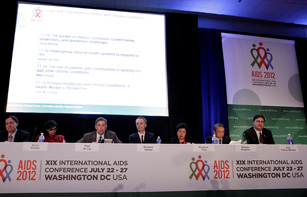
L to R: Dr Jarbas Barbosa da Silva Jr (Government of Brazil), Dr Sania Nishtar (Heartfile), Dr Paul De Lay (UNAIDS), Dr Richard Horton (the Lancet), Dr Margaret Chan (WHO), Dr Masato Mugitani (Government of Japan), Dr Ariel Pablos-MÉndez (USAID).
Credit: UNAIDS/Y.Gripas
Advances in HIV care and treatment that keep people alive while controlling, although not curing, their conditions have led to growing numbers of people surviving with chronic illnesses including HIV infection.
A satellite session at the 19th International AIDS Conference in Washington, DC, examined how service delivery has evolved in addressing HIV as a chronic health issue, and what can be learned from the experience when it comes to preventing and controlling other chronic conditions. Titled "Care and treatment for people with chronic conditions: What can we learn from the HIV experience?” the meeting also identified synergies across HIV, Non-communicable diseases (NCDs)–– such as cardiovascular diseases, cancers, diabetes and chronic respiratory diseases—and other chronic conditions when it comes to health systems strengthening.
As access to antiretroviral therapy expands, the HIV response is evolving from a disease-specific emergency response to a chronic disease management challenge which needs to be addressed within the context of other chronic health conditions. This epidemiological transition, coupled with a fast growing number of people with other chronic diseases has considerable implications for health systems and societies.
Non-communicable diseases (NCDs)––in particular cardiovascular diseases, cancers, chronic respiratory diseases and diabetes––are the biggest cause of death worldwide. More than 36 million people die annually from NCDs, including 9 million people who die before the age of 60. More than 90% of these premature deaths occur in developing countries and could have largely been prevented.
People living with HIV often also have high rates of non-communicable diseases. With HIV programmes rapidly expanding, people with HIV are living longer and ageing, and are developing non-HIV-related chronic conditions similar to the rest of the population.
UNAIDS is committed to take AIDS out of isolation and strengthen integration with NCDs by accelerating collaboration with WHO and partners
UNAIDS Deputy Executive Director, Programme, Dr Paul De Lay
In this context, the UNAIDS Secretariat and WHO have signed a Letter of Agreement to accelerate collaboration to address common agendas of HIV and non-communicable diseases. Both organisations will now collaborate to facilitate low- and middle-income countries to successfully address their diseases burden of HIV and non-communicable diseases.
“UNAIDS is committed to take AIDS out of isolation and strengthen integration with NCDs by accelerating collaboration with WHO and partners,” said UNAIDS Deputy Executive Director, Programme, Dr Paul De Lay. “2011 United Nations Political Declaration on HIV/AIDS demands that we link and integrate our HIV response to Non Communicable Diseases. We need to take on our biggest health and development challenges of our time HIV and NCDs together,” he added.
In a number of settings, it has already been possible to use the HIV lessons learnt and synergize with NCD programmes. In Ethiopia, for example, lessons learnt from HIV have served to support diabetes services. In Cambodia, two MÉdecins Sans Frontières (Doctors Without Borders) clinics combined HIV, diabetes and hypertension care services, while in Kenya, FHI 360 has added non-communicable diseases care to existing HIV programmes. In South Africa, a massive unified health testing campaign for HIV, elevated blood pressure and diabetes is underway.
HIV and other chronic diseases
Experience in addressing HIV and non-communicable diseases shows that many of the challenges are common: organizing and delivering adequate prevention services; chronic treatment and care; addressing the social and environmental determinants of these health issues; and reaching people without access to services.
The benefits of an integrated approach are reflected in better access to comprehensive care, cost savings and reduced morbidity and mortality. However, a lot still needs to be done.
According to participants at the session, summarized by Dr Masato Mugitani, Assistant Minister for Global Health, Japan and Board Chair of the Global Health Workforce Alliance, activities need to be coordinated across the continuum of care, from prevention to treatment, care and support. A particular challenge is ensuring a prepared, motivated, supported and well-functioning health workforce. Other areas of equal importance are creating equitable access to medicine and technologies; effective and integrated information systems; and robust population based surveillance.




